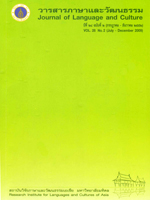An analysis of textual meaning in some selected Burmese religious tales
Main Article Content
Abstract
This study aims to investigate textual resources in some selected Burmesereligious tales by using a Systemic Functional Grammar approach focusing on theTheme system. In Burmese, the Theme system consists of Theme choices, Theme selection, and Theme types. There are textual, interpersonal and topical Themes which can be chosen as a point of departure of the clause. Textual elements which function to connect the meaning of the clauses are found in Theme position, while those which function to link simple clauses into a clause complex appear in Rheme. Therefore, the profiles of textual Theme in Burmese include only the textual elements which appear in the Theme position but do not cover the other which appear in Rheme position. Topical Theme can be either marked or unmarked. Unmarked Theme is the most selected Theme, functioning as the participants of the tales whose story is developed through them. Most of the instances of marked Theme are temporal and spatial circumstances which function to set the scene of the tales. Marked Themes in Burmese, which is an SOV language, are the effects of moving focused elements, to pre-verbal position. Theme can be presented either in single or multiple types. The realization of Theme system in textual meaning reflects some of the characteristics of both Burmese and narrative discourse.
Article Details
How to Cite
Rattanapitak, A. (2014). An analysis of textual meaning in some selected Burmese religious tales. Journal of Language and Culture, 28(2), 57. retrieved from https://so03.tci-thaijo.org/index.php/JLC/article/view/20201
Section
Research Articles
The articles featured in the Journal of Language and Culture (JLC) constitute academic works representing the viewpoints of the respective author(s). It is crucial to note that these opinions do not necessarily reflect those of the Editorial Board.
All articles published in JLC are released under the Creative Commons Attribution 4.0 International License (CC BY 4.0). This license grants permission for unrestricted use, distribution, and reproduction in any medium, provided proper credit is given to the original author(s) and the source.


